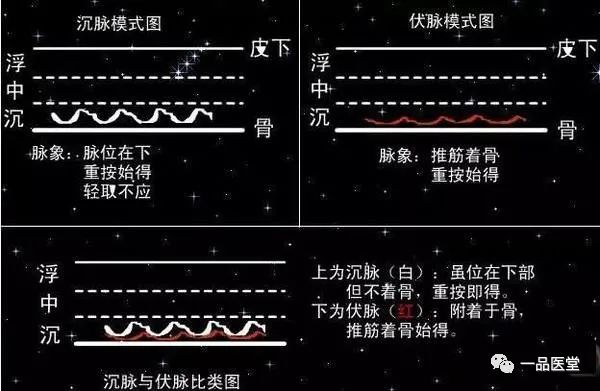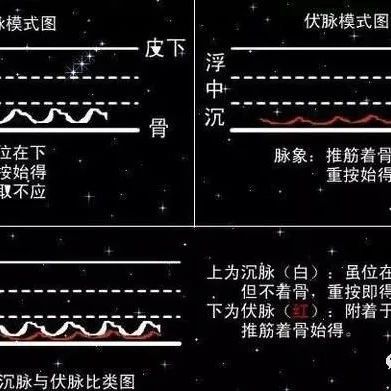Deep Pulse (Yin):
 Characteristics: Light pressure does not yield a response, but heavy pressure reveals the pulse. It is insufficient when lifted and excessive when pressed. The location of the deep pulse is deeper than that of a normal pulse, hence it can be understood as a “deep pulse”. The pulse characteristics indicate that the pulsation occurs beneath the skin and closer to the bones, making it undetectable with light pressure, only noticeable with moderate pressure, and distinctly felt only with heavy pressure. This is due to the deep nature of the pulse qi, which is located deeper.Clinical Significance: Commonly seen in interior conditions. A strong pulse indicates interior excess, while a weak pulse indicates interior deficiency. The deep pulse is a Yin pulse, referred to as “stone pulse” in the Huangdi Neijing. Individuals with a larger body fat have deeper pulses; during winter, the qi and blood contract, leading to a deeper pulse. If a person has deep and thin pulses in both hands without clinical manifestations, it is considered a normal pulse and not a pathological condition. The formation of a pathological deep pulse is primarily due to two reasons: first, internal stagnation of pathogenic factors with sufficient righteous qi, leading to qi stagnation and blood stasis, where Yang qi is obstructed and cannot propel the pulse qi outward, resulting in a strong deep pulse, which can be seen in conditions like qi stagnation, blood stasis, phlegm retention, and food accumulation; second, insufficient qi and blood, or weak Yang qi that cannot rise and propel, resulting in a weak deep pulse, which can be seen in various organ deficiencies.Deep Pulse Location and Associated Conditions:At the Cun position, it indicates phlegm stagnation and water retention in the chest; at the Guan position, it indicates cold pain and obstruction; at the Chi position, it indicates dampness and diarrhea, as well as kidney deficiency leading to lower back pain. A deep pulse at the Cun position may indicate water retention in the chest, while at the Guan position, it may indicate cold stagnation in the spleen and stomach. A deep pulse at the Chi position may indicate dampness, enuresis, diarrhea, and can also be due to kidney essence deficiency causing lower back pain.Similar Pulse Differentiation:Like a stone thrown into water, the pulse is deep, soft and smooth between the muscles and bones, firm often resides in the deep, hidden pulse pushes against the muscles and bones.(1) Hidden Pulse (Yin): Characteristics: Requires heavy pressure to feel, may not be evident at times. The hidden pulse represents a deep and concealed state, characterized by a pulse that is deeper than the deep pulse, hidden beneath the muscles and attached to the bones. Therefore, during pulse diagnosis, light or moderate pressure should not be used; heavy pressure must be applied directly to the bone, then the muscles must be pushed to feel the pulse, which may even be temporarily hidden.Clinical Significance: Commonly seen in patients with closed pathogenic factors, syncope, and extreme pain. The hidden pulse often indicates that pathogenic qi is concealed and cannot be expressed. The blockage of pathogenic qi leads to stagnation of qi and blood, preventing the righteous qi from circulating, resulting in a pulse that is hidden but strong, often seen in acute illnesses. If the pathogenic factors are hidden, it can lead to conditions like qi stagnation, heat closure, or phlegm closure. The hidden pulse in critical conditions differs from the absence of pulse caused by vascular diseases, which often occurs in a specific limb, while other pulse locations may be normal.Hidden Pulse Location and Associated Conditions: Food stagnation in the chest at both Cun positions, desire to vomit but unable, often feeling heavy; at the Guan position, it indicates abdominal pain and heaviness; at the Chi position, it indicates severe hernia pain as if the abdomen is splitting. The hidden pulse at both Cun positions indicates food stagnation in the chest, with symptoms of wanting to vomit but unable, feeling heavy; at the Guan position, it indicates abdominal pain and heaviness; at the Chi position, it indicates severe hernia pain.(2) Firm Pulse (Yin within Yang):Characteristics: Deep, strong, long, firm, and immovable. The firm pulse indicates a solid and stable condition. The characteristics of the firm pulse are that it is deep, long, and has a strong and firm quality. The firm pulse cannot be felt with light or moderate pressure. It can only be felt with deep pressure, and the pulsation is strong. It is a composite pulse of five characteristics: deep, strong, large, firm, and long. The firm pulse requires even more pressure than the deep pulse to be detected, hence it is described as resembling both deep and hidden pulses, indicating its location. It is described as strong and long, indicating its form.Clinical Significance: Commonly seen in conditions of internal cold and hernia accumulation. The firm pulse indicates diseases of internal cold and excess, generally associated with excess pathogenic factors, where liver qi stagnation and cold pathogens prevail, and spleen Yang deficiency cannot transform, leading to abdominal pain and cold, often resulting in a firm pulse. When the pathogenic factors are solidified, but the righteous qi is not weakened, such as in cases of internal accumulation of cold, where Yang qi sinks, or qi and blood stagnation, leading to masses that are solid and immovable, the pulse manifests as a deep, strong, and firm pulse. If there is blood loss or chronic illness leading to deficiency, the firm pulse may indicate a critical condition.Similar Pulse Differentiation: Deep pulse, hidden pulse, firm pulse: All three pulse types are located deep beneath the skin, hence light pressure does not yield a response. The difference is that the deep pulse can be felt with heavy pressure without needing to push against the muscles and bones; the hidden pulse is deeper than the deep pulse and requires pushing against the muscles and bones to be felt, and may even be temporarily hidden; the firm pulse is deeper than the deep pulse, resembling both deep and hidden, strong, long, slightly firm, and immovable.
Characteristics: Light pressure does not yield a response, but heavy pressure reveals the pulse. It is insufficient when lifted and excessive when pressed. The location of the deep pulse is deeper than that of a normal pulse, hence it can be understood as a “deep pulse”. The pulse characteristics indicate that the pulsation occurs beneath the skin and closer to the bones, making it undetectable with light pressure, only noticeable with moderate pressure, and distinctly felt only with heavy pressure. This is due to the deep nature of the pulse qi, which is located deeper.Clinical Significance: Commonly seen in interior conditions. A strong pulse indicates interior excess, while a weak pulse indicates interior deficiency. The deep pulse is a Yin pulse, referred to as “stone pulse” in the Huangdi Neijing. Individuals with a larger body fat have deeper pulses; during winter, the qi and blood contract, leading to a deeper pulse. If a person has deep and thin pulses in both hands without clinical manifestations, it is considered a normal pulse and not a pathological condition. The formation of a pathological deep pulse is primarily due to two reasons: first, internal stagnation of pathogenic factors with sufficient righteous qi, leading to qi stagnation and blood stasis, where Yang qi is obstructed and cannot propel the pulse qi outward, resulting in a strong deep pulse, which can be seen in conditions like qi stagnation, blood stasis, phlegm retention, and food accumulation; second, insufficient qi and blood, or weak Yang qi that cannot rise and propel, resulting in a weak deep pulse, which can be seen in various organ deficiencies.Deep Pulse Location and Associated Conditions:At the Cun position, it indicates phlegm stagnation and water retention in the chest; at the Guan position, it indicates cold pain and obstruction; at the Chi position, it indicates dampness and diarrhea, as well as kidney deficiency leading to lower back pain. A deep pulse at the Cun position may indicate water retention in the chest, while at the Guan position, it may indicate cold stagnation in the spleen and stomach. A deep pulse at the Chi position may indicate dampness, enuresis, diarrhea, and can also be due to kidney essence deficiency causing lower back pain.Similar Pulse Differentiation:Like a stone thrown into water, the pulse is deep, soft and smooth between the muscles and bones, firm often resides in the deep, hidden pulse pushes against the muscles and bones.(1) Hidden Pulse (Yin): Characteristics: Requires heavy pressure to feel, may not be evident at times. The hidden pulse represents a deep and concealed state, characterized by a pulse that is deeper than the deep pulse, hidden beneath the muscles and attached to the bones. Therefore, during pulse diagnosis, light or moderate pressure should not be used; heavy pressure must be applied directly to the bone, then the muscles must be pushed to feel the pulse, which may even be temporarily hidden.Clinical Significance: Commonly seen in patients with closed pathogenic factors, syncope, and extreme pain. The hidden pulse often indicates that pathogenic qi is concealed and cannot be expressed. The blockage of pathogenic qi leads to stagnation of qi and blood, preventing the righteous qi from circulating, resulting in a pulse that is hidden but strong, often seen in acute illnesses. If the pathogenic factors are hidden, it can lead to conditions like qi stagnation, heat closure, or phlegm closure. The hidden pulse in critical conditions differs from the absence of pulse caused by vascular diseases, which often occurs in a specific limb, while other pulse locations may be normal.Hidden Pulse Location and Associated Conditions: Food stagnation in the chest at both Cun positions, desire to vomit but unable, often feeling heavy; at the Guan position, it indicates abdominal pain and heaviness; at the Chi position, it indicates severe hernia pain as if the abdomen is splitting. The hidden pulse at both Cun positions indicates food stagnation in the chest, with symptoms of wanting to vomit but unable, feeling heavy; at the Guan position, it indicates abdominal pain and heaviness; at the Chi position, it indicates severe hernia pain.(2) Firm Pulse (Yin within Yang):Characteristics: Deep, strong, long, firm, and immovable. The firm pulse indicates a solid and stable condition. The characteristics of the firm pulse are that it is deep, long, and has a strong and firm quality. The firm pulse cannot be felt with light or moderate pressure. It can only be felt with deep pressure, and the pulsation is strong. It is a composite pulse of five characteristics: deep, strong, large, firm, and long. The firm pulse requires even more pressure than the deep pulse to be detected, hence it is described as resembling both deep and hidden pulses, indicating its location. It is described as strong and long, indicating its form.Clinical Significance: Commonly seen in conditions of internal cold and hernia accumulation. The firm pulse indicates diseases of internal cold and excess, generally associated with excess pathogenic factors, where liver qi stagnation and cold pathogens prevail, and spleen Yang deficiency cannot transform, leading to abdominal pain and cold, often resulting in a firm pulse. When the pathogenic factors are solidified, but the righteous qi is not weakened, such as in cases of internal accumulation of cold, where Yang qi sinks, or qi and blood stagnation, leading to masses that are solid and immovable, the pulse manifests as a deep, strong, and firm pulse. If there is blood loss or chronic illness leading to deficiency, the firm pulse may indicate a critical condition.Similar Pulse Differentiation: Deep pulse, hidden pulse, firm pulse: All three pulse types are located deep beneath the skin, hence light pressure does not yield a response. The difference is that the deep pulse can be felt with heavy pressure without needing to push against the muscles and bones; the hidden pulse is deeper than the deep pulse and requires pushing against the muscles and bones to be felt, and may even be temporarily hidden; the firm pulse is deeper than the deep pulse, resembling both deep and hidden, strong, long, slightly firm, and immovable.

Mechanisms, Characteristics, and Clinical Significance of Floating Pulse
Understanding Organ Function, Expanding the Use of Classical Formulas

